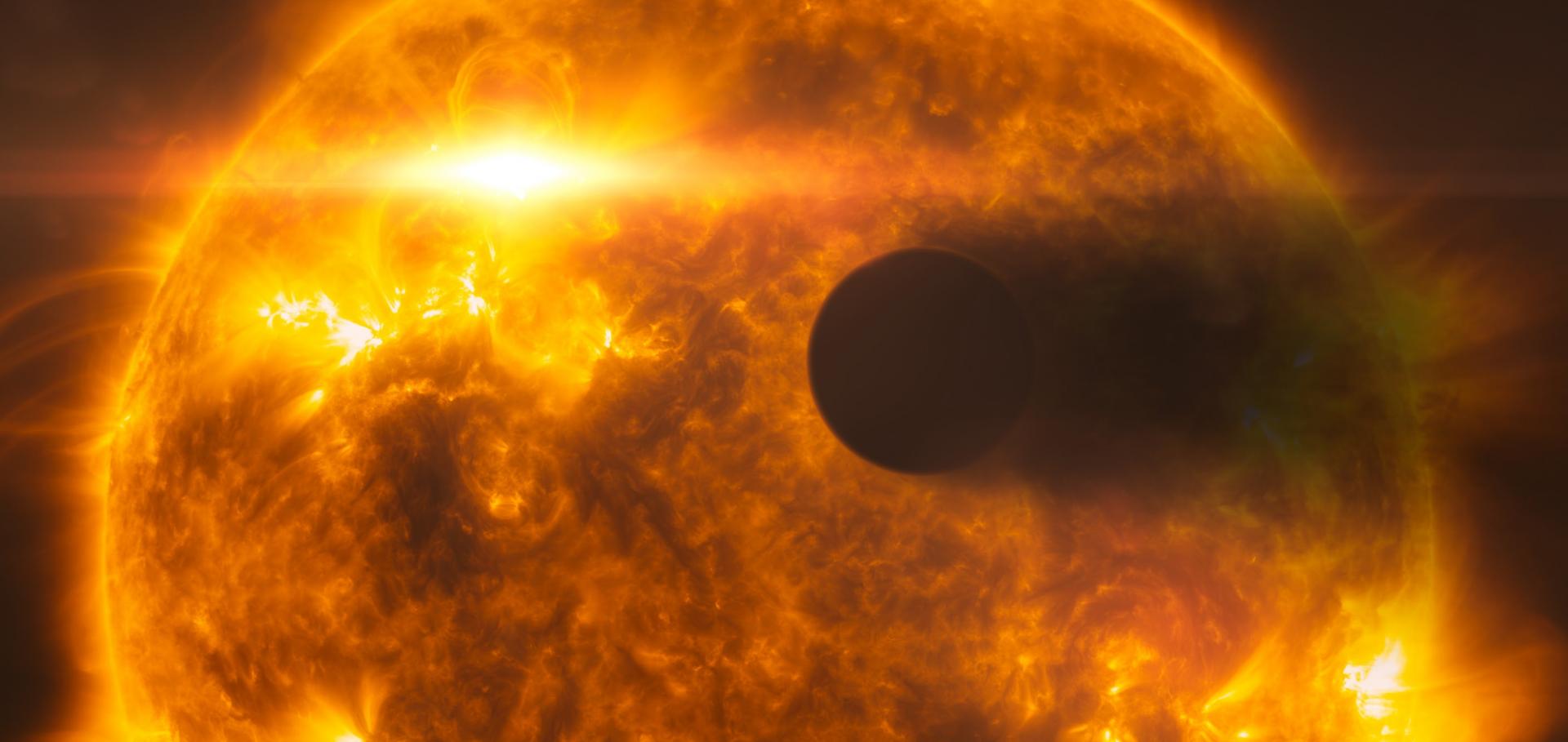Hst hot jupiter transmission spectral survey: Detection of water in HAT-P-1b from WFC3 near-IR spatial scan observations
Monthly Notices of the Royal Astronomical Society 435:4 (2013) 3481-3493
Abstract:
We present Hubble Space Telescope near-infrared transmission spectroscopy of the transiting hot-Jupiter HAT-P-1b. We observed one transit withWide Field Camera 3 using the G141 lowresolution grism to cover thewavelength range 1.087-1.678μm. These time series observations were taken with the newly available spatial-scan mode that increases the duty cycle by nearly a factor of 2, thus improving the resulting photometric precision of the data. We measure a planetto-star radius ratio of Rp/R* = 0.117 09 ± 0.000 38 in the white light curve with the centre of transit occurring at 245 6114.345 ± 0.000 133 (JD). We achieve S/N levels per exposure of 1840 (0.061 per cent) at a resolution of δλ = 19.2 nm (R ~ 70) in the 1.1173-1.6549 μm spectral region, providing the precision necessary to probe the transmission spectrum of the planet at close to the resolution limit of the instrument. We compute the transmission spectrum using both single target and differential photometry with similar results. The resultant transmission spectrum shows a significant absorption above the 5s level matching the 1.4 μm water absorption band. In solar composition models, the water absorption is sensitive to the ~1 m bar pressure levels at the terminator. The detected absorption agrees with that predicted by a 1000K isothermal model, as well as with that predicted by a planetary-averaged temperature model. © 2013 The Authors. Published by Oxford University Press on behalf of the Royal Astronomical Society.Hubble space telescope hot jupiter transmission spectral survey: A detection of na and strong optical absorption in HAT-P-1b
Monthly Notices of the Royal Astronomical Society 437:1 (2013) 46-66
Abstract:
We present an optical to near-infrared transmission spectrum of the hot JupiterHAT-P-1b, based on Hubble Space Telescope observations, covering the spectral regime from 0.29 to 1.027μm with Space Telescope Imaging Spectrograph (STIS), which is coupled with a recent Wide Field Camera 3 (WFC3) transit (1.087 to 1.687μm). We derive refined physical parameters of the HAT-P-1 system, including an improved orbital ephemeris. The transmission spectrum shows a strong absorption signature shortward of 0.55μm, with a strong blueward slope into the near-ultraviolet. We detect atmospheric sodium absorption at a 3.3σ significance level, but find no evidence for the potassium feature. The red data imply a marginally flat spectrum with a tentative absorption enhancement at wavelength longer than ~0.85μm. The STIS and WFC3 spectra differ significantly in absolute radius level (4.3 ± 1.6 pressure scaleheights), implying strong optical absorption in the atmosphere of HAT-P-1b. The optical to near-infrared difference cannot be explained by stellar activity, as simultaneous stellar activity monitoring of the G0V HAT-P-1b host star and its identical companion show no significant activity that could explain the result. We compare the complete STIS and WFC3 transmission spectrum with theoretical atmospheric models which include haze, sodium and an extra optical absorber. We find that both an optical absorber and a supersolar sodium to water abundance ratio might be a scenario explaining the HAT-P-1b observations. Our results suggest that strong optical absorbers may be a dominant atmospheric feature in some hot Jupiter exoplanets. © 2013 The Authors Published by Oxford University Press on behalf of the Royal Astronomical Society.The optical transmission spectrum of the hot Jupiter HAT-P-32b: Clouds explain the absence of broad spectral features?
Monthly Notices of the Royal Astronomical Society 436:4 (2013) 2974-2988
Abstract:
We report Gemini-North Gemini Multi-Object Spectrograph observations of the inflated hot Jupiter HAT-P-32b during two primary transits. We simultaneously observed two comparison stars and used differential spectrophotometry to produce multiwavelength light curves. 'White' light curves and 29 'spectral' light curves were extracted for each transit and analysed to refine the system parameters and produce transmission spectra from 520 to 930 nm in ̃ 14 nm bins. The light curves contain time-varyingwhite noise as well as time-correlated noise, and we used a Gaussian process model to fit this complex noise model. Common mode corrections derived from the white light-curve fits were applied to the spectral light curves which significantly improved our precision, reaching typical uncertainties in the transit depth of ̃ 2 × 10-4, corresponding to about half a pressure scale height. The low-resolution transmission spectra are consistent with a featureless model, and we can confidently rule out broad features larger than about one scale height. The absence of Na/K wings or prominent TiO/VO features is most easily explained by grey absorption from clouds in the upper atmosphere, masking the spectral features. However, we cannot confidently rule out clear atmosphere models with low abundances (̃ 10-3 solar) of TiO, VO or even metal hydrides masking the Na and K wings. A smaller scale height or ionization could also contribute to muted spectral features, but alone are unable to account for the absence of features reported here ©2013 The Authors.The prevalence of dust on the exoplanet HD 189733b from Hubble and Spitzer observations
Monthly Notices of the Royal Astronomical Society 432:4 (2013) 2917-2944
Abstract:
The hot jupiter hd 189733b is the most extensively observed exoplanet. its atmosphere has been detected and characterized in transmission and eclipse spectroscopy, and its phase curve measured at several wavelengths. this paper brings together the results of our campaign to obtain the complete transmission spectrum of the atmosphere of this planet from uv to infrared with the hubble space telescope, using the stis, acs and wfc3 instruments. we provide a new tabulation of the transmission spectrum across the entire visible and infrared range. the radius ratio in each wavelength band was re-derived, where necessary, to ensure a consistent treatment of the bulk transit parameters and stellar limb darkening. special care was taken to correct for, and derive realistic estimates of the uncertainties due to, both occulted and unocculted star spots. the combined spectrum is very different from the predictions of cloud-free models for hot jupiters: it is dominated by rayleigh scattering over the whole visible and near-infrared range, the only detected features being narrow sodium and potassium lines. we interpret this as the signature of a haze of condensate grains extending over at least five scaleheights. we show that a dust-dominated atmosphere could also explain several puzzling features of the emission spectrum and phase curves, including the large amplitude of the phase curve at 3.6 μm, the small hotspot longitude shift and the hot mid-infrared emission spectrum. we discuss possible compositions and derive some first-order estimates for the properties of the putative condensate haze/clouds. we finish by speculating that the dichotomy between the two observationally defined classes of hot jupiter atmospheres, of which hd 189733b and hd 209458b are the prototypes, might not be whether they possess a temperature inversion, but whether they are clear or dusty. we also consider the possibility of a continuum of cloud properties between hot jupiters, young jupiters and l-type brown dwarfs. © 2013 The Authors Published by Oxford University Press on behalf of the Royal Astronomical Society.The secondary eclipses of WASP-19b as seen by the ASTEP 400 telescope from Antarctica
Astronomy and Astrophysics 553 (2013)


